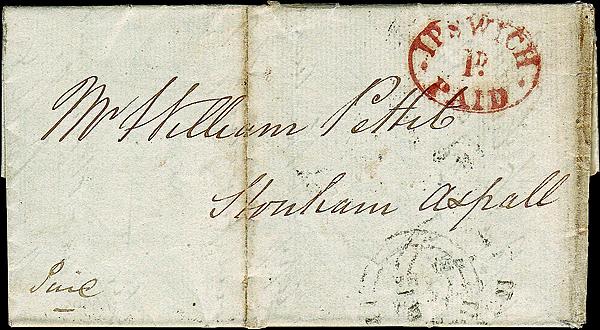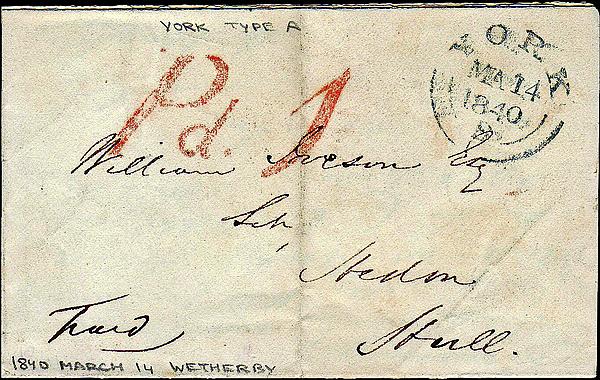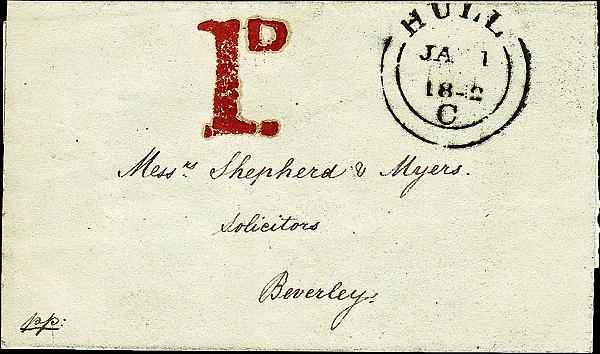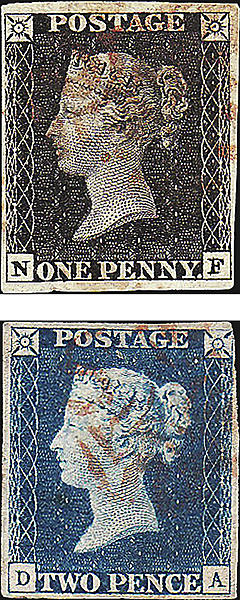World Stamps
Britain’s penny paid uniform penny postage handstamps
Uniform penny postage began in Great Britain Jan. 10, 1840. The new postal scheme meant that a letter could be sent from any place in the kingdom to any other place, no matter how far, for 1 penny.
Two things were required. First, the letter had to weigh less than ½ ounce, and second, the 1d postage had to be prepaid.
Prepayment of postage was encouraged with financial incentive.
A letter could be sent for 1d as long as the postage was paid at the time of mailing. If the postage was to be collected from the recipient at the time of delivery, the cost was double, 2d.
According to the Newark circular datestamp on the back, the folded letter shown in Figure 1 was mailed to Nottingham Jan. 27, 1840, just 17 days after the start of uniform penny postage. The “P.1” manuscript marking in red ink indicates that 1d was paid at the time of mailing.
After the start of uniform penny postage, charges that were prepaid were indicated in red ink. Charges marked in black ink meant they were to be collected from the recipient upon delivery, and the charge would have been indicated with the numeral “2.”
Figure 2 shows a nonprepaid cover. Mailed in June 1841, a year and five months after the start of uniform penny postage, the 1d postage was not paid at the time of posting. Therefore, the number “2” in black ink indicated the postal carrier had to collect 2d at the time of delivery.
The first adhesive postage stamps, which stamp collectors call Penny Blacks and Tuppenny Blues, are shown in Figure 3. They were not available to use on mail until May 6, 1840, almost four months after the start of uniform penny postage.
Until post offices could provide postage stamps as receipts for the payment of postage charges, they marked prepaid items in red ink with some indication that the tariff had been paid. This often was simply a vertical pen stroke denoting the numeral “1.”
To make processing the new high volume of prepaid mail quick and easy, post offices around the country began to have handstamps made.
The cover shown in Figure 4 bears an example of one of the custom-made handstamps.
A large numeral “1” with the “D” abbreviation for denarius or penny in red ink makes a visually stunning marking.
The double arc datestamp in black to the right of the large paid stamp indicates this particular uniform penny postage handstamp was used by the post office in Hull.
Handstamps of the uniform penny postage period were made locally by postmasters, not provided by the post office from central locations in London and Edinburgh. Therefore, these postmarks are individual in design.
An abbreviation for paid, “Pd.,” in italic letters and a large, slightly bowed and serif number “1” shown on the cover in Figure 5 was used by the city of York to indicate the prepayment of the penny postage at the time of mailing on March 14, 1840.
Collecting examples of the more than 400 identifiably different types of 1d paid handstamps makes a visually attractive and challenging specialty for British postal history collectors.
A monograph by Steve Walker, Uniform Penny Post: Handstruck Paid Postage Stamps of England and Wales 1840-1853, illustrates many of the recorded penny post handstamp markings.
Published in 2013 by the Great Britain Philatelic Society, it is the most recent and definitive research book on handstruck penny paid postage handstamps.
Walker’s book is available from the society for £15 (about US$25) plus postage of £5. It can be ordered from the society at www.gbps.org.uk/publications/books/uniform-penny-post.php.
In his book, Walker reproduces more than 300 tracings of the documented penny post 1d paid handstamps and matches them with the towns and cities that used them. Figure 6 shows two examples of differing styles.
Many markings are a simple vertical stroke indicating the number 1, such as the example on the left in Figure 6, which was used at Leeds.
Other styles included the word “PAID” or some abbreviation of it such as “P” or “Pd.” The tracing on the right in Figure 6 was used on mail accepted at the post office in Hastings.
A few handstamps include the name of the place where they were used, such as the handstamp in Figure 7 from Ipswich.
The entire marking is surrounded by an oblong frame.
In addition, ovals, rectangles, squares and even a shield were used as frames.
Handstruck penny paid markings also were used in Scotland and Ireland, but Walker limits his presentation to those of England and Wales.
Sharp, clearly inked impressions are much sought after by collectors. They are collected both as whole covers or as pieces cut from covers.
The use of uniform penny postage handstruck penny paid marks was discontinued around 1859, when the post office made it compulsory that the prepayment of postage on inland mail had to be paid using adhesive postage stamps.
MORE RELATED ARTICLES
Headlines
-
Postal Updates
Oct 7, 2024, 5 PMUSPS plans to raise postal rates five times in next three years
-
US Stamps
Oct 7, 2024, 3 PMMcMurtrie dismissed as APS education director following Sept. 21 arrest
-
US Stamps
Oct 7, 2024, 12 PMVasiliauskas named president of Mystic Stamp Co.
-
US Stamps
Oct 6, 2024, 5 PMApgar souvenir card available












